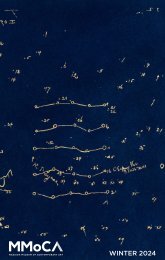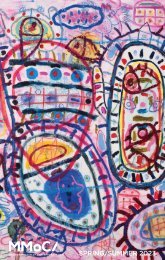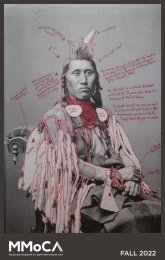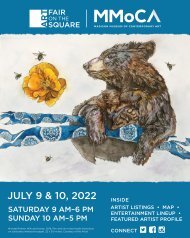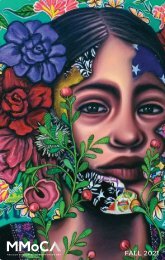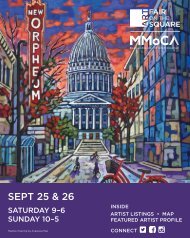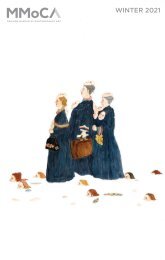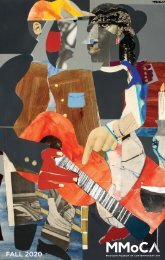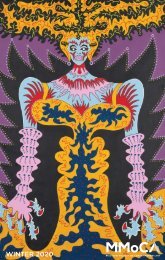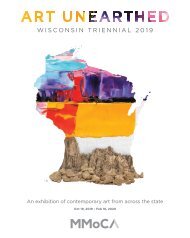Kambui Olujimi: Zulu Time exhibition catalog
This catalog is from the installation of this exhibition at MMoCA. It includes essays by Sampada Aranke, Leah Kolb, and Gregory Volk.
This catalog is from the installation of this exhibition at MMoCA. It includes essays by Sampada Aranke, Leah Kolb, and Gregory Volk.
Create successful ePaper yourself
Turn your PDF publications into a flip-book with our unique Google optimized e-Paper software.
Although these works register as largely abstract, they are<br />
made of non-abstract objects from the world at large, as opposed to<br />
components created by the artist in his studio. They loosely hint at<br />
human figures—perhaps even totemic figures or deities—with circles<br />
suggesting heads and strands and chains suggesting bodies and limbs.<br />
Elegantly sweeping across the wall, these strands and chains also<br />
resemble the gently arching lines drawn on maps to indicate great circle<br />
routes—the shortest distance between two points on the surface of a<br />
sphere. Although great circle routes appear arched on two-dimensional<br />
maps, the actual flight paths are straight lines along our threedimensional<br />
earth.<br />
<strong>Zulu</strong> <strong>Time</strong>, the title of the <strong>exhibition</strong>, similarly signals a<br />
clash between different systems of information and different ways of<br />
representing the world. This is the military and civil aviation term for<br />
Coordinated Universal <strong>Time</strong> (UTC), an even more accurate calibration<br />
that supersedes Greenwich Mean <strong>Time</strong> (GMT). Based on zero degrees<br />
longitude, which runs through the Royal Naval Observatory southeast<br />
of London, GMT originated in the nineteenth-century during the<br />
heyday of the British Empire when Great Britain fancied itself as the<br />
center of the world. It is paradoxical and ironic, to say the least, that<br />
the term <strong>Zulu</strong> time points inescapably to the <strong>Zulu</strong> people of Southern<br />
Africa, who fiercely battled the invading British in late 1878 and 1879<br />
before being brutally defeated and colonized. However unwittingly,<br />
this term is encoded with conquest, colonialism, ethnic and racial<br />
identity, and flat out racism.<br />
Look more closely at the works I’ve mentioned and you<br />
discover—perhaps you are startled to discover—exactly what the<br />
materials are. The metal circles are actual handcuffs. They come with<br />
shuddering connotations. In this era of devastating mass incarceration,<br />
these are the restraining devices routinely used by (predominately<br />
white) police officers on (disproportionally black) arrestees. They<br />
are not a symbol of power and subjugation, but rather the actual tools<br />
used by the powerful to subjugate others, tools at the front lines of<br />
systemic racism. That’s one reference. Another is to the gruesome<br />
shackles and manacles used—again routinely—in crammed ships,<br />
auction blocks, and plantations throughout the centuries-long ordeal<br />
of the Middle Passage. The other elements of these works are low-end<br />
costume jewelry, not Cartier or Bulgari from the flagship stores where<br />
the wealthy (largely white) people shop, but affordable adornments<br />
from the neighborhood. Still, this lowbrow bling does not look<br />
tacky, trashy, or abased. Instead it looks downright resplendent.<br />
<strong>Olujimi</strong>’s works allow you see how transformative and<br />
disruptive he really is, as he shifts familiar objects from their normal<br />
contexts, positions, and functions, combining them not just into fresh<br />
and surprising new conditions, but also into a fresh and surprising<br />
new life. Otherwise threatening and scary handcuffs now look fanciful<br />
and inviting. Cheap costume jewelry looks energetic and bedazzling.<br />
Small, enthralling, sensual details abound: a single pearl nestled<br />
against one link in a gold chain, the sensitive way that a light blue<br />
teardrop earring reflects both light and neighboring gold chains.<br />
36 37






